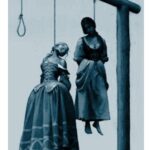
The girl who had accused Campbell of stealing milk was the victim of their curse, which was their crime.
The truth is that the girl developed an unidentified sickness following this incident, which caused her to experience extreme hysterics or catatonic states. During her visits, ash, coal, chicken bones, and balls of hair were discovered within her mouth—hints that pointed to witchcraft rituals.
Together with Lang and Campbell, 35 other individuals—two of them were boys—were also charged, given hanging sentences, and later burned (some allegedly still alive throughout the process).
The Paisley Witches, sometimes referred to as the Bargarran Witches or the Renfrewshire Witches, are the facts.
In 1696, John Shaw’s 11-year-old daughter Christian, alleged that she had been cursed by one of the household’s female servants. During this period any accusation of witchcraft was taken very seriously and proven cases were punishable by death. According to the handwritten accounts, possibly by her father, she suffered fits during which she was rendered blind and mute and vomited up pins, hair balls, feathers, bones, straw, and other objects. Witnesses testified that they had seen her suspended in the air and moved around by an invisible force.
The first servant she accused was Katherine Campbell, and later an elderly widow named Agnes Nasmith. But it wasn’t long before she was adding other names to her list to be interrogated. Those questioned named others and soon more than 30 people were accused of being involved. But only six of them would die; hanged and burned for witchcraft, with one committing suicide before the sentence was carried out.
It is suggested that Christian held a grudge against Katherine Campbell, after being reprimanded by her and it was this that spurred her accusations. Perhaps the girl thought the servant would merely be punished and did not realise how dangerous making allegations like this it could be. Once she had started the ruse, there was no going back.
This was the first time a Scottish witch trial had been triggered by alleged demonic possession. Christian Shaw, who came to be known as the ‘Bargarran Imposter’, went on to found the Renfrewshire thread industry, introducing the spinning of fine linen thread to Scotland and the development of her own “Bagarran Thread”. She later married Rev. John Miller, the minister of Kilmaurs, on September 8, 1718. After his death in 1721, she returned to the business she had started. Her second marriage was to William Gillespie, a glove manufacturer, in Edinburgh in 1737; she died later that year and is buried in Grey Friars Kirk, Edinburgh.
Who knows if she felt any guilt about what she had done?
Sources:
Witch hunt: The Great Scottish Witchcraft Trials of 1697, Isabel Adam
Paisley: A History, Sylvia Clark
The Decline and End of Scottish Witch-hunting, Brian P. Levack
(and two links in comments)










Leave a Reply